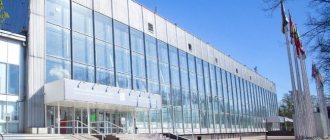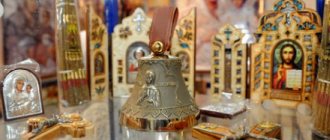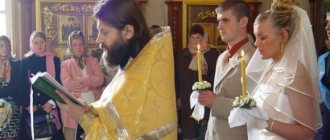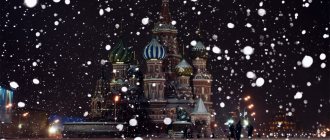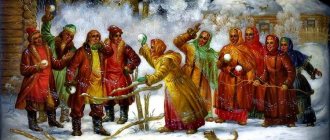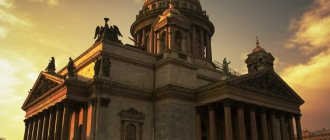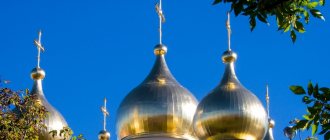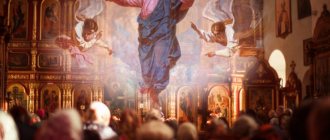| Assumption Cathedral of the Vyatka Trifonovsky Monastery |
Vyatka and Sloboda Diocese of
the Vyatka Metropolis of the Russian Orthodox Church
- Diocesan administration: Russia, 610000, Vyatka (Kirov), st. Gorbacheva, 4, Trifonov Monastery
- Tel./fax (secretary of the diocesan administration), 67-51-11 (reception of the diocese manager)
- Official site:
- Canonical territory: Kirov, Kirovo-Chepetsk, Slobodskoy GO; ZATO Pervomaisky; as well as Verkhoshizhemsky, Kirovo-Chepetsky, Kumensky, Orichevsky, Oryol, Slobodsky, Sovetsky and Yuryansky districts of the Kirov region.
- Cathedrals: Assumption Trifonov Monastery in Vyatka, Catherine’s in Slobodskoye [1]
- On the map: Yandex.Map, Google map
The Birth of Orthodoxy on the Vyatka Land
Region of the Vyatka diocese until the 13th century.
was the region where the Cheremis and Votyaks lived, lost in the vast expanses of forest. The southern part of the region was part of the Bulgarian kingdom. From the 13th century Russian colonists began to penetrate Vyatka from the north, bringing Christianity to the Novgorod region. Until the end in. Vyatka remained completely independent from anyone, either politically or religiously. With the invasion of the Tatars, the southern part of it became their subject. Having established their power within the Bulgarian kingdom, the Tatars gradually expanded their influence and subjugated almost the entire north of the Vyatka region.
With the conquest of Vyatka to the Moscow prince in 1489, this region in church terms was subordinated to the Metropolitan region; the space to the south of Vyatka remained with the Kazan Tatars.
With the fall of Kazan under the blows of Russian weapons in 1555, the rest of the Vyatka diocese was subordinated to the power of the Moscow Grand Duke and, in ecclesiastical terms, became part of the Kazan diocese.
But Vyatka’s ecclesiastical dependence on Kazan remained only on paper. Separated from Kazan by impenetrable forests and settlements of Tatars and Cheremis, after 1555 Vyatka turned to Moscow for all church needs. In 1598, the Vyatka archpriest of St. Nicholas Cathedral calls himself the patriarchal clerk; the southern part of the territories, which later became part of the Vyatka province, from the years. Malmyzh and Urzhum, founded in 1587, the villages of Elabuga and Sarapul, which already existed at the very beginning of the 16th century, were ecclesiastical subordinate to the Kazan Archbishop.
Establishment of the diocese
According to the conciliar resolution of December 5, 1657, by the will of the Tsar and the blessing of Patriarch Nikon, the independent Vyatka diocese was opened. Among the motives for its opening was the fact that “this country, cities and places of property are full of people”
and that
“there are many remains of pagan customs there
.
The Vyatka diocese included the Vyatka country, which until now constituted one of the patriarchal tithes and included five Vyatka cities: Khlynov (now Vyatka), Slobodskaya, Orlov, Kotelnich and Shestakov. Moreover, Great Perm, which consisted of the Cherdyn and Solikamsk districts, which had previously belonged to the Vologda bishop, the Kaigorod district, the estates of the Stroganov barons and the Pyskorsky monastery, which belonged to the patriarch, came under the jurisdiction of the Vyatka bishop from the Novgorod quarter. Thus, the boundaries of the Vyatka diocese in the east were the Ural Mountains, in the southeast - the river. Sylva, a tributary of the Chusovaya, in the south there is a line from Kukarka to the east, in the west there are populated areas between the river. Vyatka and Vetluga, in the north - the upper reaches of the Kama and Vychegda. By decision of the council of 1657, the bishop of the newly opened diocese was given the title of Vyatka and Great Perm. At that time, the Vyatka diocese included 138 churches.
The consolidation of the diocese apparently continued further, since there is a message that “... in 1672, most of the Great Perm diocese... was subordinated to the bishops of Vyatka...”.
Since March 12, 1682 - archbishopric.
Since 1991, the activities of the Vyatka Theological School have been resumed. Since 1996, St. Tryphon educational readings have been held annually in the city of Vyatka (Kirov); in 1998, the Vyatka Orthodox Gymnasium of St. Tryphon of Vyatka was opened.
On October 4, 2012, the independent Urzhum and Yaran dioceses were separated from the Vyatka diocese, after which the city districts, as well as Verkhoshizhemsky, Kirovo-Chepetsky, Kumensky, Orichevsky, Oryol, Slobodsky, Sovetsky and Yuryansky districts in the middle part of the Kirov region remained under the jurisdiction of the Vyatka department. At the same time, the Vyatka diocese was determined to be the center of the newly established Vyatka Metropolis.
Historical names
- Vyatka and Velikoperm (1657 - 1799)
- Vyatskaya and Slobodskaya (1799 - ?)
- Vyatskaya and Glazovskaya (? - 1921)
- Vyatskaya and Slobodskaya (1921 - 1934)
- Kirovskaya and Slobodskaya (1934 - April 21, 1994)
- Vyatskaya and Slobodskaya (since April 21, 1994)
Statistics
- 1862 - churches - 539 (stone - 409, wooden - 130). There are 5 monasteries (male - 3, female - 2). There are 1292 clergy, 69 monastics, 155 novices and novices [2].
- 1900 - churches - 751 (cathedral - 20, monastic - 22, parish and district - 587, house and state institutions - 27, Edinoverie - 12, cemetery - 54, assigned and abolished - 29). White clergy: archpriests - 41, priests - 1047, deacons - 15; psalmists - 85. Staff: archpriests - 3, priests - 66, deacons - 15, psalmists - 85. Monasteries - 9 (male - 4; female - 5). Monastics - 183 (monks - 52, nuns - 131), novices - 110, novices - 829. Theological seminary (pupils - 403), women's diocesan schools - 2 (pupils - 622), men's theological schools - 6 (pupils - 794) . There are 1005 parish schools, 11 second-grade schools, 12 two-grade schools, 486 one-grade schools, 498 literacy schools (38,481 students in primary schools) [3].
- 1912 - bishops' houses - 2. Temples - 847, chapels and prayer houses - 705. Monasteries - 11 (of which 5 are women's), 2 women's communities. Theological seminary, theological schools - 6, diocesan women's schools - 2. Church schools - 848. Church libraries - 589 [4].
- no later than 1917 - parishes - 866 (in the city of Vyatka, for 56 thousand inhabitants there are more than 50 churches, including home and hospital ones). Clergy - 1853. Monasteries - 13. Monastics - more than 200. Novices and novices - 1300.
- January 1, 1958 [5] - 80 registered temples/houses of worship.
- 2000s - parishes - 175, churches - 165 (of which 17 operate within the regional center), houses of worship - 14, chapels - 11. Clergy - 200. Monasteries - 9.
- December 31, 2011 - parishes - 253 (including 151 religious organizations and 102 religious groups). There are 212 full-time clergy (183 presbyters, 29 deacons). Monasteries - 7 (male - 2, female - 5) [6]
- December 1, 2013 - 4 monasteries, 69 parishes, 136 clergy (including monastics),
- January 2021 - 136 churches and other places of worship (houses of prayer and rooms, chapels); 137 full-time clergy (116 priests, 21 deacons) [7]
Archpastors
- Alexander (December 5, 1657 - January 8, 1674)
- Jonah (Baranov) (August 23, 1674 - October 8, 1699)
- Dionysius (Ushakov) (August 4, 1700 - January 25, 1719) [8].
- Alexy (Titov) (January 25, 1719 - September 26, 1733) [9]
- Lavrenty (Gorka) (September 26, 1733 - April 9, 1737) [10]
- Cyprian (Skripitsyn) (December 31, 1737 - May 18, 1739) [11]
- Veniamin (Sakhnovsky) (May 18, 1739 - December 2, 1742)
- Varlaam (Skamnitsky) (February 27, 1743 - February 28, 1748) [12]
- Anthony (Ilyashevich) (May 25, 1748 - November 16, 1755) [13]
- Bartholomew (Lyubarsky) (June 19, 1758 - June 5, 1774)
- Lavrentiy (Baranovich) (August 6, 1774 - March 13, 1796)
- Ambrose (Orlin) (June 1, 1796 - January 29, 1804) [14]
- Seraphim (Glagolevsky) (January 29, 1804 - July 7, 1805)
- Gideon (Ilyin-Zamatsky) (August 20, 1805 - May 3, 1817) [15]
- Ambrose (Rozhdestvensky-Veshchezerov) (July 15, 1817 - October 28, 1822)
- Pavel (Morev-Pavlov) (May 21, 1823 - March 19, 1827)
- Kirill (Bogoslovsky-Platonov) (March 26, 1827 - January 24, 1832)
- Ioannikiy (Obraztsov) (April 3, 1832 - November 16, 1835)
- Neil (Isakovic) (December 8, 1835 - April 23, 1838)
- Neophyte (Sosnin) (April 23, 1838 - March 29, 1851)
- Elpidifor (Benediktov) (March 29, 1851 - January 7, 1860)
- Nikodim (Kazantsev) (May 18, 1859 - March 25, 1860) v/u, bishop. Cheboksary
- Pavel (Pospelov) (1912) v/u, ep. Glazovsky
- Simeon (Mikhailov) (March 5, 1924 - December 22, 1925) v/u, bishop. Glazovsky
- schisp. Victor (Ostrovidov) (1926) v/u, ep. Izhevsky
- Stefan (Bekh) (1926) v/u, ep. Izhevsky
- Simeon (Mikhailov), 2nd time (May 1926 - June 21, 1927) high school, bishop. Glazovsky
- Nektary (Trezvinsky) (?) v/u, ep. Yaransky
- sschmch. Onisim (Pylaev) (1927) v/u, ep. Votkinsk
- Stefan (Bekh), 2nd time (1929) v/u, ep. Izhevsky [18]
- Nikifor (Efimov) (January - April 1929) high school, ep. Kotelnichesky
- Avraamiy (Dernov) (February 22, 1929 - 1931) v/u, bishop. Glazovsky
- Seraphim (Trofimov) (October 1930 - February 1931) high school, ep. Yaransky
- Evgeny (Zernov) (September 8, 1933 - May 16, 1934) supreme, archbishop. Kotelnichesky
- Tobiah (Ostroumov) (1945) v/u, ep. Sverdlovsky
- Gabriel (Ogorodnikov) (1957) v/u, ep. Vologda
- John (Timofeev) (January 5, 2011 - March 22, 2011) v/u, archbishop. Yoshkar-Olinsky
Story
Christianity was brought to the Vyatka land at the end of the 12th century. immigrants from Veliky Novgorod, who founded several fortified settlements here. In memory of those times, the diocese holds a daily religious procession to the village of Nikulchino, which stands on the site of the first Christian settlement. After 200 years, the city of Vyatka (Khlynov) was founded.
At this time, its surroundings were subject to the authority of the Rostov bishops. In 1383, the main diocesan shrine was found - the miraculous icon of St. Nicholas the Wonderworker. Her appearance took place on the Velikaya River, where a procession of the cross takes place annually in the first days of June. Before the revolution, more than 25,000 people took part in it.
Velikoretsk religious procession
Spiritual and monastic ministry actively developed in the Vyatka lands even before the formation of an independent diocese. By the end of the 17th century. There were 20 monastic communities and about 40 parish churches, built mainly from wood.
In 1657, the Holy Synod decided to form an independent diocese, the center of which was the city of Khlynov. The first bishops made many efforts to bring local traditions into conformity with the Orthodox Faith. Bishop Alexander and Archbishop Jonah also prepared the canonization of the first Vyatka saints:
- Venerable Tryphon of Vyatka - founder of the Assumption Monastery;
- Blessed Procopius - a disciple famous for his non-covetousness and meekness;
- Rev. Leonid of Ustnedumsky is a preacher who spreads Orthodoxy in the north of the region.
Bishops Bartholomew and Lawrence made a great contribution to the Christian education of the Vyatka peoples. Under them, a diocesan theological seminary was founded, which became the basis for a spiritual and educational center.
The formation of an independent diocese contributed to the development of stone temple construction. At the beginning of the 20th century, there were more than 8.5 hundred parish churches and 13 monasteries in the region. The total number of clergy and monastics exceeded 3,000 people.
Church of the Nativity of John the Baptist in Kirov
The first decades of the Soviet regime brought many trials to Vyatka Christians. In the 30s More than 850 churches were closed and destroyed, including the unique Alexander Nevsky Cathedral, built according to Witberg’s design in the mid-19th century. Many clergymen who remained faithful to the Lord and the Orthodox Church until the last minute suffered martyrdom.
The first attempts to revive spiritual life in the Vyatka basin began after the end of the Great Patriotic War. Thanks to the efforts of Archbishop Benjamin, the number of parishes increased to 80 units. Khrushchev's anti-religious policy led to the closure of more than half of the revived churches.
The full restoration of the Vyatka diocese began in the late 80s. last century. Under Metropolitan Chrysanthus the following important events took place:
- restoration of 120 temples;
- resumption of monastic service in the Dormition Tryphon Monastery;
- the beginning of classes at a religious school located in the city of Vyatka;
- opening of an Orthodox gymnasium named after St. Tikhon of Vyatka.
At the beginning of this century, the process of canonization of devotees of the faith who suffered during the religious persecution of the Soviet regime began.
Shrines
On the territory of the Vyatka and Sloboda diocese there are many shrines. Today, active restoration of religious buildings damaged during the Soviet years and the construction of new churches are underway. The holy images located in them attract not only local parishioners, but also pilgrims from other regions.
Cancer with the relics of Tryphon of Vyatka in the Assumption Cathedral
Temples
The oldest wooden Vyatka churches have not survived to the present day. The oldest religious buildings date back to the end of the 17th century. These include the following shrines:
- The Holy Assumption Cathedral, located on the territory of the Trifonov Monastery, was erected in 1684-1689. It is the oldest religious building in the diocese.
- The Church of the Nativity of John the Baptist is one of the oldest stone buildings in Kirov. It was erected in one year, 1714, in the unique Vyatka Baroque style. During the Soviet years, a planetarium was located here.
- Spassky Cathedral of the city of Kirov - built in the 60-70s of the 18th century. Named in honor of the miraculous image of the Savior Not Made by Hands, which before the revolution was kept in the majestic temple.
Interesting: at present, on Vyatka land there are many ancient churches at the stage of restoration, in the restoration of which Orthodox youth associations are actively participating.
Monasteries
On the territory subordinate to the Vyatka department there are three monastic communities:
- Preobrazhensky Convent, founded in the 30s. XVIII century north of the Khlynovo Kremlin;
- the men's Holy Dormition Tryphon Convent, founded by Saint Tryphon of Vyatka at the end of the 16th century;
- The Nativity of Christ convent in the city of Slobodskaya, founded in the first quarter of the 17th century.
Slobodskoy Nativity of Christ Convent
Structure
The Vyatka diocese is an administrative unit of the Russian Orthodox Church, which has an orderly structure. It is headed by Metropolitan Mark of Vyatka and Slobodskoy, who is also the head of the Vyatka Metropolis.
Metropolitan of Vyatka and Slobodskoy Mark
Diocesan departments
The relevant diocesan units are responsible for managing certain issues of spiritual, social and missionary activity.
- The missionary department promotes the creation of Orthodox educational institutions at all levels. Also, its specialists cooperate with secular educational organizations that teach spiritual and moral disciplines. On the basis of the department, work is carried out to combat addictions and various sectarian movements. The work is carried out in close cooperation with the department of religious education and catechesis.
- Departments for interaction with the armed forces and the Cossacks are engaged in the spiritual outreach of military units and Cossack communities, organizing joint events, and improving the spiritual and moral climate in the military environment.
- The Prison Ministry department provides services to correctional officers and inmates. They provide religious education and spiritual support to people serving sentences, and contribute to their socialization after release.
- Social issues are dealt with by the departments of social service and the commission for family, motherhood and childhood affairs. Specialists and volunteers from public organizations provide spiritual and material support to low-income families, single mothers, children and the elderly who are left without the care of loved ones.
- The youth department organizes religious and educational work among the younger generation. Orthodox young people participate in cultural and sports events, construction and restoration of churches, and helping needy groups of the population.
Deanery
The Vyatka department consists of 79 parishes, united into 6 deaneries. Two of them are located in the city of Kirov. The following deaneries are located within the central districts of the region:
- Slobodskoe;
- Orlovskoe;
- Kirovo-Pecherskoe;
- Kukarskoe.
Holy Dormition Trifonov Monastery
Monastic communities operating on the territory of the diocese are under the jurisdiction of the territorially corresponding deanery. In parishes and monasteries, spiritual service is carried out by 144 clergy.
Educational establishments
In the Vyatka diocese there are various types of religious educational institutions:
- Sunday parochial schools;
- Orthodox kindergarten No. 145 in the city of Kirov;
- Vyatka Theological School;
- Christian educational center at the Church of the Icon of the Mother of God “Joy of All Who Sorrow”, located in the city of Kirov.
Mass media
The diocesan administration has organized the work of a press center, which is in charge of issues of interaction with the media. Its specialists are also involved in maintaining the official Internet resource of the diocese, publishing the weekly printed publication “Diocesan Bulletin,” and preparing the television program “Word of Faith,” aired on the federal channel “Soyuz.”
